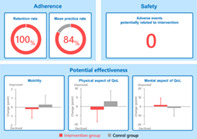- Record: found
- Abstract: found
- Article: found
Adherence, safety and potential effectiveness of a home‐based Radio‐Taiso exercise program in older adults with frailty: A pilot randomized controlled trial

Read this article at
Abstract
Aim
Radio‐Taiso, a traditional exercise program in Japan, may serve as a coping strategy for older adults with frailty during the COVID‐19 pandemic. This phase II trial tested program adherence and safety and explored the potential effectiveness of a home‐based Radio‐Taiso.
Methods
This assessor‐blind parallel randomized controlled trial included community‐dwelling Jolder Japanese adults with frailty and pre‐frailty. Fifty‐eight eligible participants were randomly allocated to intervention and control groups. Intervention participants performed 3–5‐min sessions of Radio‐Taiso one to four times per day for 12 weeks. Feasibility criteria were set at practice and retention rates of ≥75%. Safety was monitored by assessing all adverse events reported by participants during the intervention period, irrespective of causality. Potential effectiveness was exploratorily assessed using items that allow clinical interpretation of changes: mobility and health‐related quality of life (HR‐QoL), assessed using the modified short physical performance battery (SPPB) and the SF‐36, respectively.
Results
Both practice (83%) and retention rates (100%) met the predetermined feasibility criteria. Eleven adverse events were reported but were supposedly unrelated to the intervention. In the intention‐to‐treat analysis, there was no clinically significant difference in the change in SPPB score between groups (−0.4 points, 95% confidence interval [CI], −1.2, 0.3); however, the intervention group scored higher in the mental component of HR‐QoL than did the control group (3.4 points, 95% CI: −1.1, 7.8).
Abstract
A traditional exercise program called Radio‐Taiso might be a reasonable coping strategy for older Japanese adults with frailty and pre‐frailty during the COVID‐19 pandemic, but no large‐scale clinical trial has evaluated the effectiveness of Radio‐Taiso on clinically important outcomes in this population. This phase II trial tested the adherence, safety and potential effectiveness of a home‐based Radio‐Taiso exercise program, and we examined the feasibility of a phase III trial. Our preliminary data indicated that the phase III trial will be feasible if the mental aspect of health‐related quality of life is used as the primary outcome.
Adherence, safety, and potential effectiveness of a home‐based Radio‐Taiso exercise program in older adults with frailty.Related collections
Most cited references25
- Record: found
- Abstract: found
- Article: found
Frailty in elderly people

- Record: found
- Abstract: found
- Article: found
